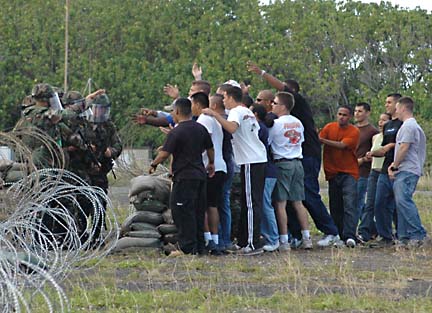
|
The nonlethal
enforcers
Marines demonstrate tools to incapacitate
unruly groups while minimizing fatalities
At a runway at the Marine Corps Base Hawaii at Kaneohe last week, an Air National Guard C-130 was rushed by a mob clamoring for food, water, medical supplies and other humanitarian aid.
Marines and Honolulu police officers held the crowd -- actually Air Force personnel -- at bay using nonlethal weapons, such as rubber balls and sting balls, but it was only a demonstration, and silhouette targets were hit by the weapons.
It was the culmination of two days of workshops and seminars hosted by Marine Forces Pacific, which is the Pacific Command's executive agent for nonlethal weapons. Ray Grundy, deputy director for the Marine Corps' nonlethal weapons program in Virginia, said the "the military is leading the way in the development and acquisition of nonlethal capabilities."
He told reporters that he sees greater use of these types of weapons by domestic law enforcement agencies.
Acting Honolulu Police Assistant Chief Bryan Wauke said he was there to see what resources the military has to offer.
"In cases involving Homeland Security, we will be working with the military and other agencies. It's good to know what they have," he said.
As part of the demonstration of crowd control, members of the Honolulu Police Department donned riot helmets and stood shoulder-to-shoulder with members of the 15th Security Forces Squadron and Kaneohe Marines from the 2nd Battalion behind a barricade of 3Ú4 -inch riot shields.
Military officials told reporters that these nonlethal weapons are designed to incapacitate personnel while minimizing fatalities, permanent injury or damage to property in the environment.
However, Capt. Chris Perrine, Marine spokesman, said: "They do not substitute for lethal weapons, but serve to augment them."
The maritime part of the demonstration involved the use of the Long Range Acoustic Device or LORAD, which was developed after the 2000 attack on the USS Cole off Yemen as a way to prevent small boats from approaching Navy warships. American Technology Corp. of San Diego recently got a $1.1 million contract from the Marine Corps to buy these auditory devices for units deployed to Iraq.
Hostile fast boats -- portrayed by the U.S. Navy -- approached the USS K-Bay, which was actually the Coast Guard cutter Walnut, and were greeted by other Coast Guard picket boats and loud audible warning broadcast by LORAD on the Walnut that they have "entered an exclusionary zone. Reverse your course and immediately exit the area."
When the aggressor boats refused to back down, members of the Coast Guard's security team moved in. Had the situation been real, the aggressors could have been met a system of nets fired from the ship or dropped by a helicopter. The nets are meant to stop the boats by getting entangled in their propellors.
The second part of the demonstration included various nonlethal munitions, ranging from rubber balls to sting balls, fired at silhouette targets by the Marines, police officers and Air Force security force members and from unmanned remote control vehicle called the Gladiator.
The 1,600-pound, tracked, unmanned vehicle, which looks like a bigger version of a Star Wars R2-D2 robot, cost $250,000 to develop. The Gladiator also can be turned into a deadly lethal weapon when armed with an M-240G machine gun or 9 mm Uzi.
It is controlled remotely by one soldier using a handheld controller.
Both the M-240 machine gun and the stingball gun are mounted on the top of the Gladiator. The stingball gun uses compressed air to fire .60-caliber paint-ball-style pellets. The Gladiator also is capable of tossing smoke grenades, riot control tear gas pellets and stingball grenades from the 30 tubes mounted on either side of the tracked vehicle.
www.mcbh.usmc.mil
[News] [Business] [Features] [Sports] [Editorial] [Do It Electric!]
[Classified Ads] [Search] [Subscribe] [Info] [Letter to Editor]
[Feedback]
